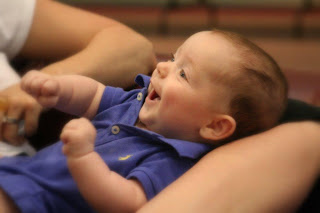




The pursuit of God, wisdom, music, and fun
Financial Peace Revisited by Dave Ramsey
I've read Financial Peace a couple times before but this time was in conjunction with going through Financial Peace University. Both the book and the course have some great information on personal finance.
The driving principles behind Ramsey's philosophy are live on a budget, pay off debt as quick as possible, build an emergency fund, and get rich slow through diversified investments rather than trying get rich quick schemes.
He describes 7 baby steps (a phrase borrowed from the movie "What About Bob?") to financial peace. The first is to go crazy to build up a $1,000 emergency fund. This will allow you to take care of true emergencies while getting out of debt. (Things like going out to eat, new clothes for school, Christmas presents, etc. would not qualify as emergencies.) This emergency fund also allows you to cut up credit cards and never use them again. Since funds are available to cover unexpected expenses credit cards are no longer necessary. (And yes you can purchase anything online, rent a car, or book a hotel with a debit card. Anything you can do with a credit card can be done with a debit card)
He quotes studies by Dunn & Bradstreet indicating that consumers purchase 12-18% more when using a credit card versus using cash. Having to look Uncle Benjamin, Abraham, George, and Andrew in the eye and tell them that they'll being going to live with someone else is an emotional experience and has an ouch factor to it that swiping a card just doesn't have. McDonald's has also done studies indicating the people paying with credit cards end up buying around 30% more than those paying with cash. So yeah, even for those paying off their card every month and getting "skymiles" or "1% cash back," you likely bought 12 to 18% more by using that credit card. Hope you enjoy the "free flight."
The second baby step is to list all debts from smallest to largest and pay minimums on all except the smallest one regardless of interest rate. Once the smallest one is paid off you would roll that money into the second smallest one and so forth. The concept is referred to as a debt snowball.
Mathematically it might seem more advantageous to pay the highest interest card first and on paper this is accurate. However, personal finance is 80% behavior and only 20% head knowledge. When you start seeing the traction and progress you're making you get excited and more focused "gazelle intense" and start really attacking the debts which result in getting out of debt quicker.
Ramsey encourages selling so much stuff the kids start hiding 'cause they think they're next and naming the dog "eBay." Picking up extra side jobs whether that be delivering pizzas, cutting grass, babysitting, cleaning houses or some other hobby which generates money is also encouraged. He also advocates paying only cash for cars not only to stay out of debt but also to avoid the beating in value you take when driving the car 10 feet off the lot.
After paying off all consumer debt not including the house if a home is owned, baby step number 3 is increasing the emergency fund to 3-6 months of expenses. This emergency fund should be placed in something that's extremely safe such as a money market or savings account. One good reason to have this amount of an emergency fund is in cases of losing a job you would have a solid 3 to 6 months to look for one without the pressure of paying bills with no income.
After building the emergency fund to 3-6 months of expenses, you then move on to baby step 4 which is investing in a retirement plan through work if they match a percentage of your contribution and then through a Roth IRA. If there is no matching from the employer in a 401k, 403b, or TSP, you would start with the Roth IRA which grows tax free. Using mutual funds with solid 10 year track records is a great diversified investment strategy for a retirement account. One would also want to spread money around to various mutual funds such as a growth & income fund, an aggressive fund, an international fund, and a value or balanced fund. The goal is to invest 15% of a paycheck into retirement.
You then move on to baby step 5 which is funding education for children. This can be done through a couple different tax defered accounts such as an Education Savings Account (ESA) or a 529 plan. Only after building up retirement should one start on the kids college. Kids can get scholarships and work to help pay for college but retirement is not something that should be put on hold. You really don't want to be eating dog food in retirement.
After all 5 of these steps are in order, you would then pay everything else down on the house as quick as possible.
Once the home is free and clear, you win and have true financial peace. At this point, you invest in 100% paid for real estate as well as continuing to invest in solid mutual funds. You can now live the life you've worked so hard for and give lots of money away.
I highly recommend this book and the Financial Peace University class to anyone. Even those who already know a good bit about personal finance can benefit from them.
This review also posted at Amazon
For additional articles I've written on personal finance topics, see the following links.
Who Can Set Up Roth IRAs
Choosing Mutual Funds for Your 401k
Why Tax Refunds Are Bad
Emergency Reserves for Later
The Importance of a Solid Financial Team

Ahoy and avast me maties. It be Talk Like A Pirate Day. Aye 'tis indeed. Be sure ta say Arrrrr!! at least once.
In A Pit With A Lion On A Snowy Day by Mark Batterson
Another way to stretch out the IT Band and the surrounding muscles is using a foam roller
. To use it, lay on your side, put the foam roller
underneath then slowly roll your leg along it. It may be tender and possibly a bit painful especially if the IT Band is significantly inflamed. Try to do 10 rolls per leg and repeat at least on a daily basis. Over time you'll notice increased mobility and reduced tightness. A foam roller is a great investment towards recovery and is available from Amazon for just $25.
The Street Lawyer by John Grisham




Rich Dad, Poor Dad by Robert Kiyosaki
The Tipping Point by Malcom Gladwell



Young Men & Fire by Norman Maclean













 Andrew and Kevin on the Continental Divide
Andrew and Kevin on the Continental Divide








